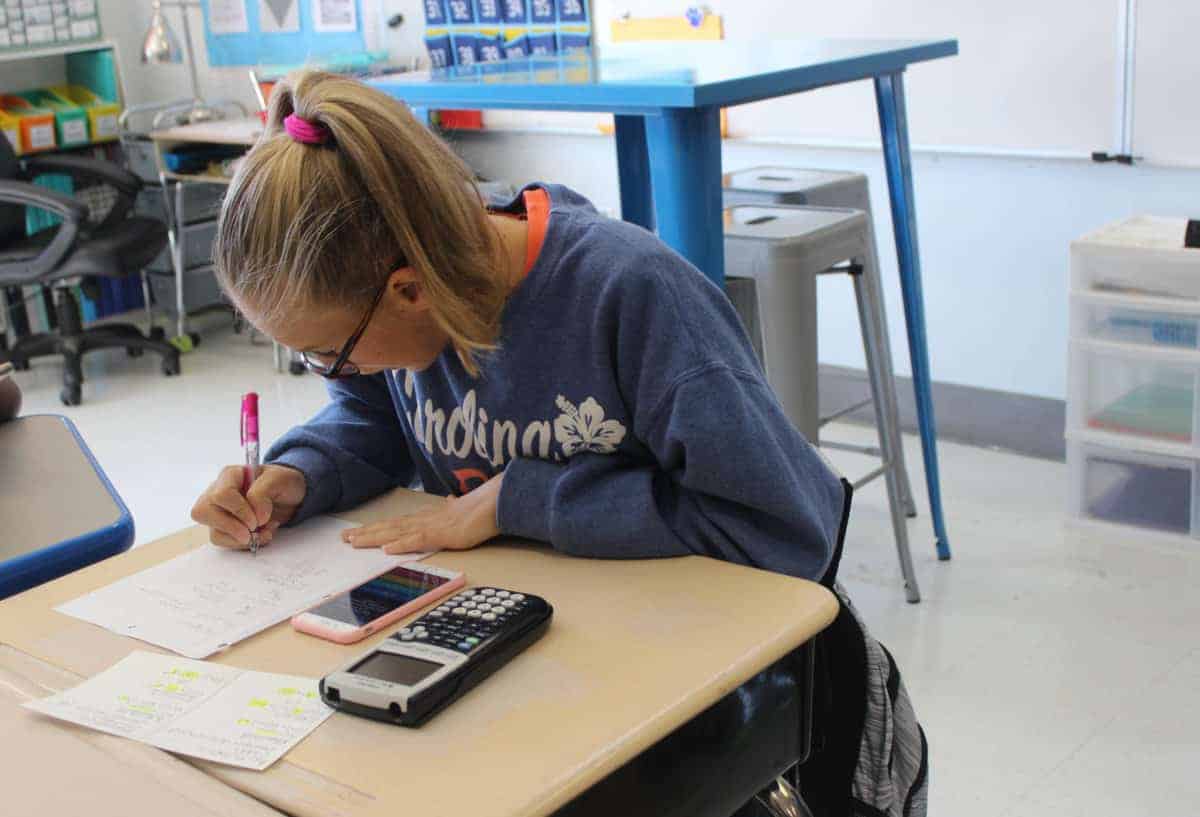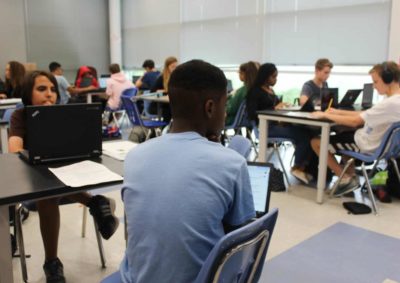“I feel like it isn’t 100 percent bad or 100 percent good. I try to use it for good things,” Grace, age 17, says of social media. But social media’s image focus, with photos that are cropped, filtered, and curated, can make maintaining emotional equanimity difficult. “It’s the root of a lot of comparison,” Grace says. “You know how your life looks. It’s hard not to compare.”
“[Social media] allows me to relax,” says Sophie, age 16, but “it can be a distraction when I need to be focused on something more important.”
“It gives me a way to keep in touch with friends I might otherwise not,” says Claire, age 14. But it can also present pressure — and pain. “Social media can be very stressful sometimes, and it can be a cause of cyberbullying,” Claire adds.
Finding balance is tough. “I think technology is positive in how it can connect me to my friends and help me find new music,” says Zoë, age 16. “But it’s negative when it becomes all anyone cares about, and when it affects my sleep and my ability to get homework done.”
National survey data also show teens see social media as a positive and negative influence in their lives. As the adage goes, it’s complicated.
On screens, mixed views prevail
Teachers understand the complexities. According to a 2018 Gallup poll, teachers generally support the learning benefits of digital devices: 42 percent see them as mostly helpful to students’ education, 30 percent view them as neutral, and 28 percent see them as mostly harmful. But teachers are quite concerned about health impacts: 69 percent say devices are mostly harmful to students’ mental health, and 55 percent say they’re mostly harmful to kids’ physical health.
What does research reveal? Impacts vary. Preliminary analyses from the ongoing federal ABCD study show more overall screen time might be harmful but social screen time might be beneficial. “Screen time predicted poor sleep, less physical activity, and more family conflict,” says Dr. Lindsay Squeglia, a clinical psychologist and one of ABCD’s principal investigators. But “more social media was related to better sleep, less family conflict, more physical activity,” she says. These early findings aren’t longitudinal and don’t show cause and effect — but they do affirm the importance of parsing out how kids use screens.
Other research on social media makes the case for caution. Heavy use has been linked with anxiety, depression, poor sleep, and low self-esteem. Social media “does have some good points, and it has some bad points,” says pediatrician Dr. Kathleen Clarke-Pearson, co-author of a 2011 clinical report on social media for the American Academy of Pediatrics (AAP).
Some children, including those with chronic health conditions, can find a supportive community online, she says. Yet sites for anorectic or bulimic children can be extremely concerning — “That’s the dire side. And then you have the regular people. The kids get on; the coach is connecting with them online. There’s a benefit to their athletic engagement, to be connected with the team online,” she says.
Girls seem to be at higher risk for adverse effects, a fact that parents suspect. According to the American Psychological Association’s 2017 Stress in America survey, “Parents of teen girls are significantly more likely to report that they worry about the influence of social media on their child’s physical and mental health (69 percent, compared to 39 percent of parents of teen boys).”
Meanwhile, concerns about girls’ overall mental health are rising. According to the latest Youth Risk Behavior Survey data from the Centers for Disease Control (CDC), depressed high schoolers are far more likely to be female: 41 percent of girls reported experiencing feelings of sadness or hopelessness daily for at least two consecutive weeks in 2017, compared to 21 percent of boys. A CDC trends report reveals significant increases in depression over the past decade have been fueled almost entirely by girls.
Digital devices and mental health
What is driving increases in depression? Some researchers are sounding the alarm on smartphones, suggesting the concurrent rise in teen depression in the years since the smartphone was introduced is unlikely to be coincidental. Social psychologist Jean Twenge is leading that charge. In her 2017 research, Twenge found that adolescents who spent more time with screens were significantly more likely to report depressive symptoms or risk factors for suicide. Social media was significantly correlated with depression, but only for girls.
What was the tipping point in screen time? Two or more hours a day with electronic devices was linked with a small increase in depressive symptoms. But kids using devices for 5+ hours daily were much more likely to have a risk factor for suicide, Twenge found.
Other research supports a link between intensive mobile phone use and depression. A 2016 study that tracked 12- to 15-year-olds for a year found a significant association between mobile phone use and later depression. Other data, assessing depression and internet use, are mixed.
In some cases, more internet time is linked with depression; in other instances, it isn’t — especially when time online is social. A research review from Harvard’s Center on Media and Child Health sums up: “Given the contradictions in the existing research, a causal relationship between depression and internet use is difficult to define.”
What else could contribute to more teens voicing symptoms of depression? “I don’t know that technology has caused all this. I can’t say that definitively,” says Tim Hardin, president of the North Carolina School Counselor Association. People are less reticent now to share struggles with mental health, says Hardin. “I just think we’re more aware of it and we’re more open. More people are more open to having honest discussions about their mental health.”
Screens and sleep
What about screens and impacts on kids’ physical health, especially sleep? Sleep struggles are common: Four in 10 parents say their teen has trouble getting to sleep and staying asleep, according to the C.S. Mott Children’s Hospital National Poll on Children’s Health. Are screens partly to blame? Parents think so: 56 percent point the finger at kids’ failure to disconnect.
They’re on to something. Kids who sleep with mobile devices are at higher risk of sleep disturbance, notes the American Academy of Pediatrics (AAP). What helps? A new study published in Computers in Human Behavior indicates sleeping apart from phones might yield dividends for sleep — and mood. Study participants who slept without smartphones for one week slept better and felt happier.
Setting screens aside well before sleep promotes real rest. Exposure to screens’ blue light before bedtime can delay sleep, disrupt sleep, and impact melatonin levels, says AAP. But disconnecting early can be especially hard for teens, who may be up late at night completing and submitting homework online. Is this practice worrisome?
“It’s absolutely a concern,” says pediatrician Dr. David Hill, Chair of AAP’s Council on Communications and Media. “One of the strongest findings of the literature on screen time for children and adults is that it can be disruptive of natural sleep times.” Hill says screens should be off 60 minutes before bed; intensity and wavelength of light probably matter some, he adds. “Data are still evolving. I do think there is a real concern as more of our students’ assignments move online.”
Screens, attention, and resilience in young children
What about young children’s development? Early screen exposure may be connected to later attentional difficulties. According to research from Dimitri Christakis, children who watch more television before age three are at higher risk for attentional problems by the time they’re seven.
Screens may also disrupt the development of children’s coping skills, if devices are used as emotional pacifiers. Clarke-Pearson says she has “very deep concern” about parental reliance on devices to placate a distressed young child. “The opportunity to develop resilience is being displaced because it’s convenient for the parent. That’s a really big issue for a lot of us in pediatrics,” she says.
Physicians also worry screen overuse is pre-empting hands-on play. AAP recently released a clinical report on the importance of play, citing digital media as one of several cultural forces impinging on playtime. Play serves many critical functions in childhood and buffers stress, according to AAP. It’s a fundamental way children process their emotions, says Clarke-Pearson. “If you have a kid on a device, they’re displaced from play time, imaginary time. That’s how kids work out their conflicts in life — with their toys and stuffed animals. It’s a phenomenally beautiful process of child development.”
In the end, research is providing timely clarity about impacts of digital media on child health. But in some cases, answers are not definitive. Why do some children benefit while others struggle? What is the exact nature of the relationship between screen overuse and mental health? Cause and effect are not yet clear, says Hill: “What researchers are still debating is whether kids with a predilection for anxiety and depression lose themselves in screens or whether the screens themselves promote … anxiety and depression.”



